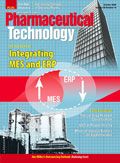Are You Ready for REMS?
A book offers a detailed introduction to the new area of risk evaluation and mitigation strategies.
The US Food and Drug Administration has the legal authority to require a risk evaluation and mitigation strategy (REMS) for drugs and biological products. If you have no idea what this means, then you should read Pharmaceutical Risk Management: Practical Applications.

Pharmaceutical Risk Management: Practical Applications, Jeffrey E. Fetterman, Wayne L. Pines, and Gary H. Slatko, Eds., Food and Drug Law Institute, Washington, DC, 2008, 287 pp., ISBN: 978-935065-00-5 (DORLING KINDERSLEY/GETTY IMAGES)
In the book's introduction, the editors contend that medical and marketing executives within the industry are now well aware that risk management may be the key to a successful drug product. Medical and marketing executives may be familiar with the current regulatory state, but plenty of other stakeholders are so ill informed that they can't even spell "REMS."
In her foreword to the book, Janet Woodcock, director of FDA's Center for Drug Evaluation and Research, notes that "the processes used to date for assuring the maximum achievable 'pharmaceutical safety' have not worked as effectively and efficiently as we would like." Pharmaceutical Risk Management is all about the evolving systematic effort to improve the safety of pharmaceuticals.
The REMS environment is new. FDA's aforementioned legal authority comes from the FDA Amendments Act (FDAAA) of 2007. The fundamental purpose of REMS is to ensure that the benefits of a drug outweigh its risks. A REMS may be required for new, approved, or supplemental drug and biologic license applications. At the other end of the spectrum, a drug is considered misbranded if a sponsor fails to comply with a REMS requirement, and significant civil monetary penalties can accrue.

(DORLING KINDERSLEY/GETTY IMAGES)
The book has the feel of a course packet, complete with handouts and reference documents. Its level of detail makes it more than a primer, but less than a comprehensive treatment.
The subject is explained in three general sections. Chapters 1 and 2 provide a historical context for REMS. Chapters 3–10 represent the nuts and bolts, applications-oriented sections. The chapters also present a case study of a global, targeted education plan to improve communication between physicians and patients and improve compliance and adherence to the medication regimen. The last two chapters provide strategic and legal considerations.
The 12 chapters are written by different, highly qualified authors, yet the editors have done a nice job of integrating the chapters and providing continuity. The content is terse and focused, with plenty of bullet lists, tables, diagrams, and references.
About half of the 287 pages are dedicated to appendices. Appendix A contains reprints of guidances such as Premarketing Risk Assessment, Development and Use of Risk Minimization Action Plans, and Good Pharmacovigilance Practices and Pharmacoepidemiologic Assessment. More regulatory documents such as FDAAA Title IX, Subtitle A; "Identification of Drug and Biological Products Deemed to Have Risk Evaluation and Mitigation Strategies for Purposes of the Food and Drug Administration Amendments Act of 2007;" and "Draft PDUFA IV Drug Safety Five-Year Plan" are included in other appendices.
Although the appendices are a convenient collection of these relevant documents, they constitute a significant portion of the bound volume. A reader might be surprised to find the end of the last chapter about halfway through the book. The appendices provide a self-contained educational tool, but most of these items are available online. Furthermore, these documents often change, and one should always check to make sure that a more recent document does not exist.
This book provides an excellent overview of the current risk-assessment and -management environment for anyone in or associated with the pharmaceutical industry. It is particularly well suited for executives in industry or government with broader responsibilities who need to understand the amplified significance and compliance requirements in this dynamic area. The book is also an excellent starting point for individuals seeking in-depth understanding because they can study the references provided in each chapter.
R. Gary Hollenbeck, PhD, is chief scientific officer at UPm Pharmaceuticals, adjunct professor of pharmaceutical sciences at the University of maryland school of Pharmacy, and a member of Pharmaceutical Technology's editorial advisory Board, 6200 seaforth st., Baltimore, mD, 21224, tel. 410.843.3745, hollenbeck@upm-inc.com

PacBio Chosen as Tech Partner for Global Alzheimer’s Disease Research Project
April 23rd 2025The project, the North African Dementia Registry, will unite multiple entities for the purpose of developing a comprehensive dataset to advance the research community’s understanding of Alzheimer’s disease and other dementias in diverse populations.